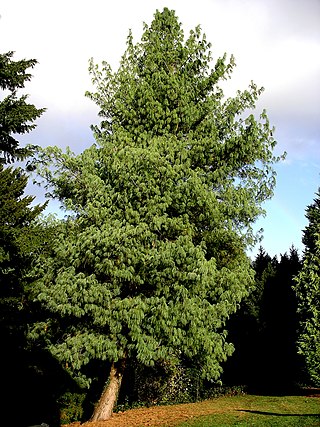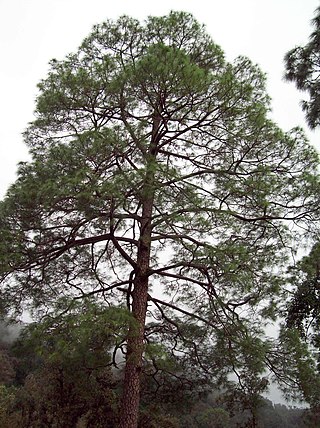
Arunachal Pradesh is a state in northeast India. It was formed from the North-East Frontier Agency (NEFA) region, and India declared it as a state on 20 February 1987. Itanagar is its capital and largest town. It borders the Indian states of Assam and Nagaland to the south. It shares international borders with Bhutan in the west, Myanmar in the east, and a disputed 1,129 km border with China's Tibet Autonomous Region in the north at the McMahon Line.

Pinus wallichiana is a coniferous evergreen tree native to the Himalaya, Karakoram and Hindu Kush mountains, from eastern Afghanistan east across northern Pakistan and north west India to Yunnan in southwest China. It grows in mountain valleys at altitudes of 1800–4300 m, reaching 30–50 m (98–164 ft) in height. It favours a temperate climate with dry winters and wet summers. In Pashto, it is known as Nishtar.

Pinus bhutanica, which may be called the Bhutan white pine, is a tree restricted to Bhutan and adjacent parts of northeast India and southwest China. Along with the related Pinus wallichiana it is a constituent of lower altitude blue pine forests. This pine reaches a height of 25 meters. Note that P. wallichiana is sometimes called by the common name 'Bhutan pine'.

Northeast India (officially the North Eastern Region(NER)) is the easternmost region of India representing both a geographic and political administrative division of the country. It comprises eight states—Arunachal Pradesh, Assam, Manipur, Meghalaya, Mizoram, Nagaland and Tripura (commonly known as the "Seven Sisters"), and the "brother" state Sikkim.

The Panax (ginseng) genus belongs to the Araliaceae (ivy) family. Panax species are characterized by the presence of ginsenosides and gintonin. Panax is one of approximately 60 plant genera with a classical disjunct east Asian and east North American distribution. Furthermore, this disjunct distribution is asymmetric as only two of the ~18 species in genus are native to North America.

Pinus roxburghii, commonly known as chir pine or longleaf Indian pine, is a species of pine tree native to the Himalayas. It was named after William Roxburgh.

Pinus gerardiana, commonly known as the chilghoza pine or neja, is a pine native to the northwestern Himalayas in Afghanistan, northern Pakistan, Waziristan and northwestern India, growing at elevations of 1,800–3,350 metres (5,910–10,990 ft). It often occurs in association with Cedrus deodara and Pinus wallichiana.

Dipterocarpus retusus, commonly known as hollong, is a large tree and perhaps the best known species in the genus Dipterocarpus. It is native to China, Vietnam, Philippines, Laos, Cambodia, Malaysia, Indonesia, Myanmar, and India. The tree, some 20–30 metres (70–100 ft) tall, is found in Cambodia in dense forests of the plains, common on hillsides and along rivers and in forests between 800 m (2,600 ft) and 1,500 m (5,000 ft) altitude.

Narkanda is a town and a nagar panchayat in Kumarsain subdivision of Shimla district in the Indian state of Himachal Pradesh. It is at an elevation of 2708 meters on the Hindustan-Tibet Road in Himachal Pradesh, India within a fir forest. It is about 60 km away from Shimla and surrounded by the Himalayan Range.

Sclater's monal also known as the crestless monal is a Himalayan pheasant. The name commemorates the British zoologist Philip Lutley Sclater.
Biermannia is a genus of flowering plants from the orchid family, Orchidaceae. It is native to eastern India, China and Southeast Asia.

The 'Eastern Himalayan subalpine conifer forests is a temperate coniferous forests ecoregion which is found in the middle and upper elevations of the eastern Middle Himalayas, in western Nepal, Bhutan, northern Indian states including Arunachal Pradesh and Sikkim and adjacent Myanmar and China.

The Western Himalayan subalpine conifer forests is a temperate coniferous forests ecoregion of the middle and upper elevations of the western Middle Himalayas of Nepal, India, and Pakistan.

Arunachal Pradesh is primarily a hilly tract nestled in the foothills of the Himalayas in northeast India. It is spread over an area of 83,743 km2 (32,333 sq mi). 98% of the geographical area is land out of which 80% is forest cover; 2% is water. River systems in the region, including those from the higher Himalayas and Patkoi and Arakan Ranges, eventually drain into the Brahmaputra River.
Musa arunachalensis is a species in the genus Musa. It was first described in 2013 by botanists from the University of Calicut in Kerala.
Nanorana arunachalensis is a species of frog in the family Ranidae that is found in streams of Lower Subansiri district, Arunachal Pradesh, India. The presence of black mark between this frog's eyes separate it from other frog species in this genus.
Trimeresurus arunachalensis, the Arunachal pitviper, is a species of venomous pit viper endemic to the Indian state of Arunachal Pradesh. It is only known from the village of Ramda in the West Kameng district, where a single specimen was discovered during biodiversity surveys. It can physically be distinguished by its scalation, its acutely pointed snout reminiscent of the hump-nosed viper, and its brownish dorsal coloration with glossy orange-reddish-brown sides and belly. The last new species of (green) pit viper was described from India 70 years before the discovery of T. arunachalensis. Genetic analysis indicates that the closest relative of this species is the Tibetan bamboo pit viper. The single specimen known of this species makes it one of the rarest known pit vipers in the world, though further surveys of the forest habitat will likely reveal more individuals.
Larsenianthus is a genus of monocotyledonous plants in the ginger family (Zingiberaceae). The genus was established in 2010. The four or so species are native to the area of the eastern Himalayas.

Dipankar Borah is an Indian field botanist from Assam.
Pinus ravii is a rare, semi-disputed species of large-sized conifer in the family Pinaceae.













